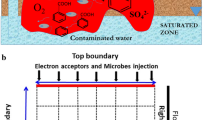Abstract
Dissolved benzene was detected in the shallow unconfined Liwa aquifer (UAE). This aquifer represents the main freshwater source for a nearby residence camp area. A finite element model is used to simulate the fate, transport, and attenuation of the dissolved benzene plume to help decision makers assess natural attenuation as a viable remediation option. Sensitivity of benzene attenuation to uncertainties in the estimation of some of the kinetic and transport parameters is studied. It was found that natural attenuation is more sensitive to microbial growth rate and half saturation coefficients of both benzene and oxygen than initial biomass concentration and dispersivity coefficients. Increasing microbial growth rate by fourfold increased natural attenuation effectiveness after 40 years by 10%; while decreasing it by fourfold decreased natural attenuation effectiveness by 77%. On the other hand, increasing half saturation coefficient by fourfold decreased natural attenuation effectiveness by 46% in 40 years. Decreasing the same parameter fourfold caused natural attenuation effectiveness to increase by 9%.




Similar content being viewed by others
References
Bauer RD, Maloszewski P, Zhang Y, Meckenstock RU, Griebler C (2008) Mixing-controlled biodegradation in a toluene plume: Results from two-dimensional laboratory experiments. J Contam Hydrol 96(1–4):150–168
Borden RC, Bedient PB (1986) Transport of dissolved hydrocarbons influenced by oxygen-limited biodegradation: 1. Theoretical development. Water Resour Res 13:973–1982
Forrest B, Arnell P (2001) Hydrocarbon delineation and pilot testing program at the Bu Hasa Liquids Recovery Plant Abu Dhabi report, UAE. Matrix Solutions Inc Report 01-47
Godeke S, Vogt C, Schirmer M (2008) Estimation of kinetic Monod parameters for anaerobic degradation of benzene in groundwater. Environ Geol 55:423–431
Guha H (2004) Biogeochemical influence on transport of chromium in manganese sediments: experimental and modeling approaches. J Contam Hydrol 70:1–36
Jean J, Tsai C, Ju S, Tsao C, Wang S (2002) Biodegradation and transport of benzene, toluene, and xylenes in a simulated aquifer: comparison of modelled and experimental results. Hydrol Proc 16:3151–3168
Johnson R, Pankow J, Bender D, Price C, Zogorski JS (2000) MTBE: To what extent will past releases contaminate community water supply wells? Environ Sci Technol 1:4A–9A
Kim DJ, Choi JW, Choi NC, Mahendran B, Lee CE (2005) Modeling of growth kinetics for Pseudomonas spp. during benzene degradation. Appl Microb Biotechnol 69:456–462
Kindred JS, Celia MA (1989) Contaminant transport and biodegradation 2: conceptual model and test simulation. Water Resour Res 25:1149–1159
MacQuarrie KTB, Sudicky EA, Frind EO (1990) Simulation of biodegradable organic contaminants in groundwater 1: numerical formulation in principal directions. Water Resour Res 26:207–222
McNab WW, Dooher BP, Rice DW, Kavanaugh MC, Johnson PC, Cullen SJ, Everett LG, Kastenberg WE (1997) Assessment of appropriate fuel hydrocarbon risk management strategies for George Air Force Base, Victorville, California using a risk based approach. Lawrence Livermore National Laboratory, University of California. UCRL-AR-125619
Miralles-Wilhelm F, Riordan P, Fitzgerald R, Harley B (1996) Intrinsic biodegradation of benzene in contaminated groundwater: a case study illustrating the application of numerical modeling. In: Wise DL, Trantolo DJ, Cichon EJ, Inyang HI, Stottmeister U (eds) Bioremediation of contaminated soils. Marcel Dekker AG, Switzerland, p 903. ISBN: 0-8247-0333-2
Mohamed M (2001) METABIOTRANS: a 3-D finite element model for contaminants transport and biotransformation in saturated groundwater. PhD dissertation. University of Florida, Gainesville, Florida, USA
Mohamed M, Hatfield K, Hassan AE (2006) Monte Carlo evaluation of microbial-mediated contaminant reactions in heterogeneous aquifers. Adv Water Resour 29:1123–1139
Mohamed M, Hatfield K, Perminova IV (2007) Evaluation of Monod kinetic parameters in the subsurface using moment analysis: theory and numerical testing. Adv Water Resour 30:2034–2050
Parcher M (1999) Assessing various technologies to remediate a hydrocarbon contaminated aquifer. MSc Thesis, Virginia Polytechnic Institute and State University, Blacksburg, Virginia
Rifai HS, Rittaler T (2005) Modeling natural attenuation of benzene with analytical and numerical models. Biodeg 16:291–304
Salvage KM, Yeh GT (1998) Development and application of a numerical model of kinetics and equilibrium microbiological and geochemical reactions BIOKEMOD. J Hydrol 209:27–52
Schafer W (2001) Predicting natural attenuation of xylene in groundwater using a numerical model. J Contam Hydrol 52:57–83
Schafer W, Therrien R (1995) Simulating transport and removal of xylene during remediation of a sandy aquifer. J Contam Hydrol 19:205–236
Schafer D, Schafer W, Kinzelbach W (1998) Simulation of reactive processes related to biodegradation in aquifers: 1. Structure of the three-dimensional reactive transport model. J Contam Hydrol 31:167–186
Schirmer M, Molson J, Frind E, Barker J (2000) Biodegradation modeling of a dissolved gasoline plume applying independent laboratory and field parameters. J Contam Hydrol 46:339–374
Weaver JW, Charbeneau RJ (2000) A screening approach to simulation of aquifer contamination by fuel hydrocarbons (BTEX and MTBE). National Exposure Research Laboratory United States Environmental Protection Agency Athens, Georgia pp 1–47
Woodward D (1996) Potential for contamination of the Liwa Aquifer by disposal of Brine in the Bu Hassa and Asab Fields, Abu Dhabi. U.S. Geological Survey Administrative Report 96-001, 76 p (prepared for the Abu Dhabi Company for Onshore Operations)
Yu J, Molstad L, Frostegård Å, Aagaard P, Breedveld GD, Bakken LR (2007) Kinetics of microbial growth and degradation of organic substrates in subsoil as affected by an inhibitor, benzotriazole: model based analyses of experimental results. Soil Bio Biochem 39:1597–1608
Acknowledgments
This research was partially funded by the Research Affairs at the UAE University (project number 08-01-7-11/09). The authors acknowledge the assistance provided by Abu-Dhabi Distribution Company (ADDC). The views expressed are the authors’ own, and do not necessarily represent those of ADDC.
Author information
Authors and Affiliations
Corresponding author
Rights and permissions
About this article
Cite this article
Mohamed, M.M., Saleh, N.E. & Sherif, M.M. Sensitivity of Benzene Natural Attenuation to Variations in Kinetic and Transport Parameters in Liwa Aquifer, UAE. Bull Environ Contam Toxicol 84, 443–449 (2010). https://doi.org/10.1007/s00128-010-9957-4
Received:
Accepted:
Published:
Issue Date:
DOI: https://doi.org/10.1007/s00128-010-9957-4




